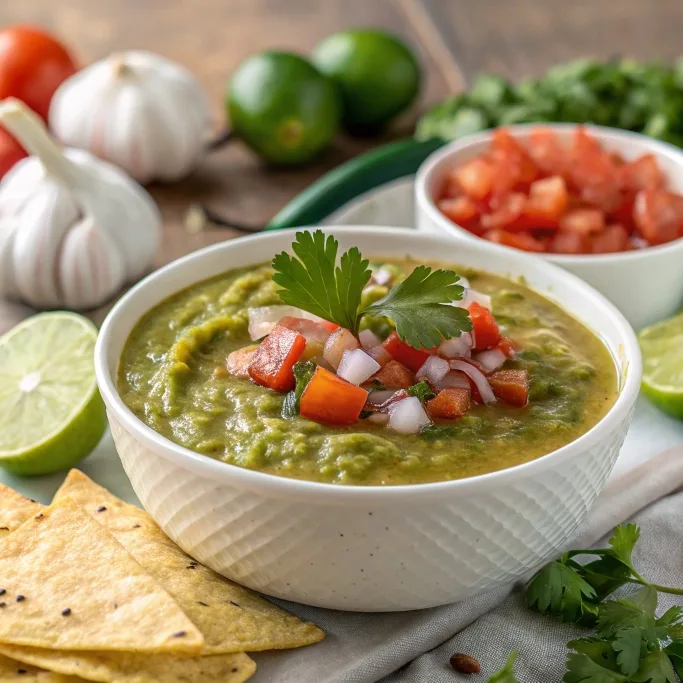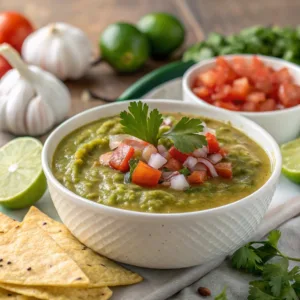
There are few things in the world of cooking that bring as much joy as dipping a crisp tortilla chip into a freshly made Roasted Salsa Verde Recipe. The smoky flavor from fire roasted tomatillos, the lively heat of chilies, and the brightness of cilantro combine to create a condiment that feels both rustic and sophisticated. Whether you are serving it alongside tacos, spooning it over grilled meats, or enjoying it with friends as a simple dip, this green sauce is a staple that transforms even the simplest dishes. In this article, we will take a deep dive into everything you need to know about roasted tomatillo salsa, from its origins to preparation tips, common mistakes, and creative serving ideas.
Why Roasted Salsa Verde Stands Out
Unlike raw salsas that rely purely on the acidity of fresh ingredients, roasting tomatillos and peppers adds a smoky complexity. Tomatillo salsa for chips becomes a whole new experience when the tomatillos are slightly charred under the broiler or on a hot skillet. The natural sugars in the tomatillos caramelize, softening their tangy bite and giving depth to the flavor. A homemade roasted tomatillo salsa verde is not just a dip; it is a cornerstone in Mexican cuisine that carries with it traditions of family meals, fiestas, and countless regional variations.
Key Ingredients in a Roasted Salsa Verde Recipe
- Tomatillos: The base of the salsa, with a tart and slightly citrusy flavor. Look for bright green, firm tomatillos with tight husks.
- Chilies: Jalapeños, serranos, or poblanos can be used, depending on how spicy you like your green salsa recipe.
- Garlic and Onion: Roasted alongside the tomatillos for a sweet, mellow base.
- Cilantro: Fresh cilantro brightens the salsa and adds an unmistakable herbal touch.
- Lime Juice: For acidity and balance, making the flavors pop.
- Salt: To enhance all the natural flavors.
With these simple ingredients, you can make a versatile salsa verde recipe that pairs beautifully with almost anything.
How to Make Roasted Tomatillo Salsa Verde
If you have ever wondered how to make roasted tomatillo salsa verde, the process is much easier than it might sound. The key lies in roasting. Here is a step by step guide:
- Preheat your oven broiler or set a heavy skillet on high heat.
- Peel and rinse your tomatillos to remove the sticky residue beneath the husk.
- Place tomatillos, chilies, garlic cloves (in their skins), and onion wedges on a baking sheet.
- Broil or pan roast until the skins blister and char, turning occasionally for even roasting. This creates that signature fire roasted tomatillo salsa flavor.
- Allow the vegetables to cool slightly, then peel garlic and remove stems from chilies.
- Blend the roasted ingredients with fresh cilantro, lime juice, and salt until smooth or slightly chunky, depending on your preference.
This method creates a homemade roasted tomatillo salsa verde that tastes vibrant, smoky, and fresh at the same time.
Why You Will Love This Salsa
- Quick and easy: Takes less than 20 minutes from start to finish.
- Budget friendly: Tomatillos and chilies are inexpensive yet flavorful.
- Big flavor payoff: Roasting enhances every ingredient.
- Versatile: Use as a dip, sauce, or marinade.
- Healthy: Low calorie, full of antioxidants and vitamin C.
Cultural Note on Roasted Tomatillo Salsa
In Mexico, roasted salsa verde recipe has been a kitchen classic for generations. Tomatillos have been cultivated since pre-Columbian times, and roasting them was a natural cooking technique long before ovens were common. Today, both traditional cooks and modern home chefs embrace roasted tomatillo salsa for its authenticity and depth of flavor. It remains a cornerstone of family gatherings, Sunday meals, and festive celebrations.
Serving Suggestions
This vibrant salsa can be enjoyed in countless ways. Here are a few popular ideas:
- Serve tomatillo salsa for chips at parties with warm tortilla chips.
- Spoon over grilled chicken or steak for a smoky and tangy complement.
- Add to tacos, burritos, or enchiladas as a zesty topping.
- Mix with mashed avocado for a quick salsa guacamole hybrid.
- Use as a sauce for eggs in the morning, especially with chilaquiles or huevos rancheros.
Pro Tips for Perfect Salsa Verde
- Do not skip roasting. That is what gives this salsa its rich flavor.
- Adjust chili quantity to control spiciness.
- Use a food processor for a chunky texture or a blender for smooth salsa.
- Always add lime juice at the end to keep flavors bright.
Common Mistakes to Avoid
- Undercooking tomatillos: Without proper roasting, the salsa can taste too sour.
- Over blending: It is okay if your salsa is not perfectly smooth. A bit of texture makes it more authentic.
- Skipping salt: Seasoning is crucial to balance acidity and spice.
- Using old tomatillos: Soft or wrinkled tomatillos will not yield a vibrant flavor.
Storage and Reheating
Your homemade roasted tomatillo salsa verde can be stored in the refrigerator in a sealed container for up to 5 days. The flavors will deepen after a day or two, making it even tastier. For longer storage, you can freeze the salsa in airtight containers or freezer bags for up to three months. To thaw, leave it in the refrigerator overnight. Since salsa is served cold or at room temperature, reheating is not necessary.
Frequently Asked Questions
What makes roasted salsa verde different from raw salsa verde?
Raw versions rely on fresh tomatillos, while roasted salsa verde recipe gains a smoky depth from charring the vegetables. Both are delicious, but roasting brings out sweetness and complexity.
Can I use roasted salsa verde in cooked dishes?
Absolutely. It is perfect in stews, enchiladas, casseroles, or as a simmering sauce for chicken or pork. Many cooks love using green salsa recipe to braise meats.
What kind of chilies should I use?
Serrano chilies give a sharper heat, while jalapeños provide milder spice. Poblanos add earthy flavor without much heat. Experiment to find your favorite roasted tomatillo salsa balance.
How spicy is salsa verde?
That depends on the number and type of chilies. If you prefer mild heat, remove seeds and membranes before roasting. For fiery flavor, include them for a stronger fire roasted tomatillo salsa.
Can I add fruit to my salsa verde?
Yes, some variations include pineapple, mango, or even avocado for a sweet or creamy twist. However, the classic salsa verde recipe sticks with tomatillos, chilies, onion, garlic, and cilantro.
Closing Thoughts
The beauty of a roasted salsa verde recipe lies in its simplicity and versatility. By roasting humble ingredients like tomatillos and chilies, you create a sauce that can brighten any meal. Whether you are looking for the best tomatillo salsa for chips, a topping for grilled meats, or a base for traditional Mexican dishes, this salsa will never disappoint. With each batch, you can adjust the flavors, experiment with textures, and even try adding fruits or different chilies. Once you make it at home, you will find yourself preparing homemade roasted tomatillo salsa verde again and again because it is just that good.
So, grab some fresh tomatillos, fire up your broiler, and give this recipe a try. Share it with family, bring it to gatherings, and make it a regular part of your cooking routine. Salsa is more than a dip; it is a tradition, a memory, and a flavor that brings people together.
Roasted Salsa Verde Recipe
Equipment
- Baking Sheet
- Broiler or Skillet
- Blender or Food Processor
Ingredients
Main Ingredients
- 1 lb tomatillos husked and rinsed
- 2-3 chilies jalapeños, serranos, or poblanos
- 1 white onion quartered
- 3 cloves garlic unpeeled
- 1 cup fresh cilantro leaves
- 1 lime juiced
- 1 tsp salt or to taste
Instructions
- Preheat oven broiler or heat a heavy skillet over high heat.
- Peel and rinse tomatillos to remove husks and sticky residue.
- Arrange tomatillos, chilies, garlic (in skins), and onion wedges on a baking sheet. Roast until skins char and blister, turning occasionally for even roasting.
- Cool slightly. Peel garlic and remove stems from chilies.
- Blend roasted vegetables with cilantro, lime juice, and salt until smooth or chunky as preferred.
- Taste and adjust seasoning with more lime or salt if needed.

